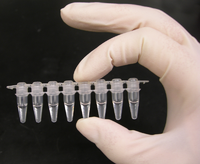
Photo from wikipedia
Transcriptome sequencing has emerged as an important research tool for exploring the mysteries of life at the single-cell level. However, its wide application is limited by the bias associated with… Click to show full abstract
Transcriptome sequencing has emerged as an important research tool for exploring the mysteries of life at the single-cell level. However, its wide application is limited by the bias associated with the amplification reactions which is essential for library building of trace RNA. In this study, low-melting-point agarose was added to the amplification reactions to take advantage of its molecular crowding effect and polymer cross-linked structure to improve the sensitivity of the reactions and reduce bias. To further evaluate the performance of the method, it was applied to transcriptome sequencing of microregion samples from brain tissue sections of mice with Parkinson's disease at the single cell level. The results showed that agarose PCR had better performance than in-tube PCR. Further application of agarose PCR to transcriptome library sequencing could obtain data closer to that of unamplified. With the addition of low melting point agarose, the sensitivity of the amplification reaction was significantly increased, while homogeneity was increased by approximately 2-fold. Not only that, but this work also provides 11% sensitivity improvement for spatial transcriptomic study on Parkinson's disease-associated gene detection. The agarose PCR provides a new tool for efficient and homogeneous amplification of trace samples and can be widely used for spatial transcriptome library sequencing and studies.
Journal Title: ACS applied materials & interfaces
Year Published: 2022
Link to full text (if available)
Share on Social Media: Sign Up to like & get
recommendations!